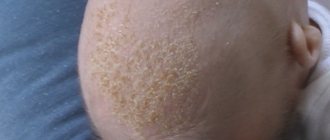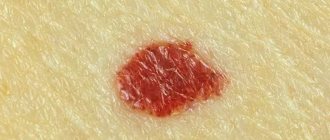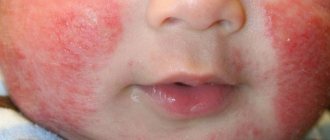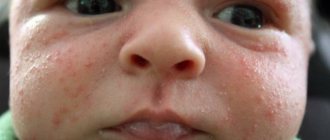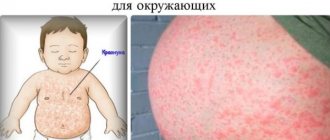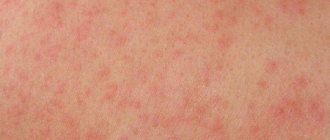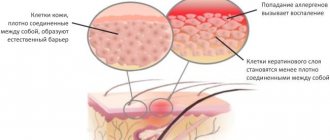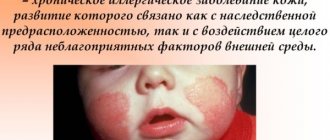Causes
Bright spots on the baby's face and scabs look scary for parents. They are caused by a lack of food enzymes in the body of a small child and insufficient breakdown of proteins. Incompletely broken down proteins enter the bloodstream, causing a negative effect on the immune system. The antibodies produced when combined with proteins lead to allergic manifestations.
Factors provoking diathesis:
- very early complementary feeding;
- consumption by the baby's mother of foods that have a high degree of allergy;
- taking certain medications;
- reaction to dry mixtures;
- problems with microflora in the intestines;
- disrupted digestive system process;
- maternal illness during pregnancy;
- predisposition to allergies.
It should be taken into account that a baby may have an individual intolerance to a number of foods, which begins to manifest itself with the introduction of complementary foods. In order to quickly identify an allergic product, parents should keep a complementary feeding diary, taking into account all new products in the child’s diet.
In addition to food, allergies can also be caused by external irritants:
- care products (baby cream, baby oil);
- synthetic materials (clothing, etc.);
- reaction to pet hair;
- powder used for washing clothes.
Symptoms
Diathesis has characteristic symptoms:
- red spots on the cheeks;
- redness on the chin;
- crusts in places of redness (appear over time).
Additionally, diaper rash can appear in skin folds and on the buttocks. In addition to reactions on the skin, disturbances in the gastrointestinal tract and even conjunctivitis may occur. A newborn baby becomes restless, irritable, and may have difficulty falling asleep.
Photo: diathesis on the face of a baby:
In the photo below you will see what diathesis looks like on a baby’s face. This will further help you determine whether your baby has any signs of an allergic rash.
Photo: Diathesis on the cheeks
How long does diathesis last and when does it go away in infants?
Diathesis is a typical manifestation that can occur even in the first days after birth. Only an allergist can say exactly how serious the situation is, having all the information about the child’s health in front of him.
The recovery period varies. If the nutrition of the baby and mother (during breastfeeding) is taken under control and allergens are excluded from the diet, then the problem of diathesis can disappear quite quickly. In some cases, it may take a couple of weeks. With a properly selected diet, diathesis usually does not appear after one year of age. In a situation where the product that caused the allergy has been excluded, but the symptoms still persist even after 3-4 weeks, you should consult a doctor. The reason for this state of affairs may be the following factors:
- decreased baby's immunity;
- manifestation of a negative allergic reaction to milk protein;
- transition of the disease from acute to chronic.
Types of diathesis
In medicine, there are more than 20 varieties of the disease. In children, the most common are neuro-arthritic, lymphatic-hypoplastic and exudative. In adults, doctors identify the following common types of diathesis
Allergic - can be classified as the most common type of disease. Methods of diagnosis and treatment are similar to those for allergies. If you do not start treating the disease in a timely manner, there is a high probability of the disease becoming chronic. This can lead to complications such as asthma, rhinitis, bronchitis.- Hemorrhagic - occurs due to the body’s predisposition to bleeding and blood diseases; it can appear from an early age.
- Uric acid - doctors define this type as a congenital pathology. The appearance of uric acid diathesis is caused by excess uric acid in the blood. If you follow the rules of a healthy diet, the disease may not manifest itself throughout a person’s life.
- Lymphatic-hypoplastic - in fact, is a set of certain hereditary diseases that cause the development of diseases of the lymphatic system, adrenal glands, thyroid gland and cardiovascular system. The skin with this type of diathesis is most often pale in color, and the general condition of the patient is lethargic and apathetic.
- Gastrointestinal - damage to the digestive organs. The intestinal microflora is disrupted and dysbacteriosis develops.
- Neuro-arthritic - a violation of the metabolism of uric acid, as well as purines. It is important to carry out timely therapy to restore water and electrolyte balance in the body.
Treatment
The principles of treatment and prescription are carried out by the attending physician. For therapy, medications, diet and traditional medicine recipes are used. Starting from the age of one month, babies can be treated with the antihistamine Fenistil orally or externally.
The usual regimen includes complex treatment:
- Oral antihistamines (Fenistil, Zyrtec, etc.).
- Probiotics (Bifidumbacterin, etc.).
- If a child is excitable due to diathesis, use fennel tea.
- External ointments and gels.
- To cleanse the body, Polysorb.
When the baby is breastfed, the mother must adhere to a diet excluding allergenic foods (honey, citrus fruits, etc.), coarse fiber and fatty foods. During complementary feeding, all new foods should be introduced one at a time at intervals. Baby care products are selected even more carefully.
Important! Self-medication can be harmful. All measures must be agreed with a doctor.
Ointments for diathesis
For effective treatment and quick relief of symptoms of diathesis, doctors prescribe external medications in the form of gels or ointments. Based on their drug groups, they are divided into non-hormonal anti-inflammatory and corticosteroid (hormonal).
The safety of the drug for infants is very important. Treatment begins with lighter remedies, such as La-Cri and Bepanten. The use of hormonal ointments occurs only after a comprehensive examination of the child. To smooth out and prevent possible side effects, it is possible to use a technique such as mixing them with baby creams before application.
Afloderm . Alclomethasone-based drug. The product quickly eliminates swelling, redness of the skin and irritation. Can be prescribed to children from six months of age once a day.
Advantan. This remedy is a local anti-inflammatory. The main substance is methylprednisolone. Can be prescribed to babies from the age of four months. The duration of treatment with this drug is no more than a month.
Uniderm. Prescribed to children from 6 months, use with caution, no more than 5 days. Active ingredient: mometasone furoate. It is an effective hormonal agent.
Bepanten. Used for diaper rash and redness, a gel can be used. This product is well suited for sensitive and inflamed skin of babies. The drug is based on dexpanthenol. The gel is quickly absorbed, non-toxic and has no restrictions on the age of the child.
Folk remedies
To treat diathesis on the cheeks, folk remedies can be used, which have proven themselves in use for many generations. These remedies should be used until the baby’s condition improves permanently.
Eggshell. Simple and easy-to-use products include a preparation based on eggshells. To prepare, eggshells are dried and ground into powder. After this, it is transferred to a glass container. This product should be taken in a minimal amount - on the tip of a knife. Before use, the powder is quenched with lemon juice.
Burdock roots. Burdock roots (1 large spoon) are thoroughly crushed and poured with hot water (a cup of boiling water). Leave for 2 hours, filter. Give the baby ¼ glass before meals.
Bay leaves. Dry bay leaves (7 or 8 pieces) are poured with a liter of boiling water and boiled for 5 minutes. After this, add a handful of rose hips and remove from the heat. It should be left overnight. Strain and give the child no more than 8 drops at a time.
Soda lotions. To relieve itching and relieve redness, dissolve a teaspoon in a glass of boiled water. Lotions based on this solution are made using cotton pads.
A large selection of remedies for diathesis makes it possible to eliminate the symptoms of the disease and alleviate the baby’s condition. Only by finding out with your doctor the cause of the diathesis and eliminating it, can you successfully cope with the disease .
General methods of treating manifestations of diathesis in a child
Each type of constitutional anomaly has its own characteristic manifestations and the methods described above for how to treat diathesis, but with all this, the constitutional anomaly manifests itself in the form of skin rashes of various types. As Dr. Komarovsky described diathesis, this is a problem that worries parents more from the aesthetic side, since rashes on the child’s skin, especially when they do not go away, worry parents much more than the number of lymphocytes in the blood or an enlarged spleen.
Treatment of diathesis in children under one year of age consists of adherence to the diet, proper nutrition of the nursing mother, as well as the careful introduction of new foods into the baby's complementary foods. When milky crusts appear on the head, it is necessary to soak them in oil and carefully remove them with a comb without injuring the delicate scalp; it is better to do this after bathing, when the skin is steamed. If spots appear, before smearing diathesis on the child’s cheeks, you should consult a pediatrician; it is possible that the doctor will advise the use of folk remedies for diathesis at such a young age.
What to smear on a child’s cheeks with diathesis? You can use ointments that have an anti-inflammatory effect, as well as relieve itching and burning - which is why children often become capricious or scratch wounds, introducing a bacterial infection into them. It is also recommended to cut the nails of infants short, and for infants up to 3 months to wear special gloves to prevent scratching of the ulcers on the cheeks.
Treatment of diathesis in children with folk remedies shows a good effect when using herbal baths, the collection of which should include plants with drying and soothing properties - chamomile, horsetail, oak bark, calendula. It is recommended to purchase a collection of herbs at a pharmacy, where the plants have undergone radiological control, but those collected independently may contain salts of heavy metals and then all their beneficial properties are neutralized in comparison with the harm caused to the baby’s delicate skin.
Another recipe for treating diathesis with folk remedies is to bathe the child in a decoction of bay leaves, which is a good antiallergic agent. To do this, 10 - 15 dry bay leaves are boiled in a liter of water and added to the bath before bathing; using soap for such bathing is not recommended.
An excellent ointment for diathesis is sea buckthorn oil; it has a moisturizing, healing and anti-inflammatory agent, soothes inflamed skin and relieves irritation. If the diathesis on the child’s cheeks does not go away or even increases, before applying pharmaceutical products, you need to read their effect and composition. Thus, zinc-based ointments (Disetin, Zinc paste) dry out the skin, which is indicated for weeping eczema, diaper rash, and ointments such as Bepanten, Panthenol, on the contrary, moisturize and regenerate the skin. Diathesis treatment, which is undertaken on time, takes place within 2–3 years without consequences.
Diathesis in infants: causes, types, treatment
Most often, parents associate the term “diathesis” with persistent allergic rashes or gneiss (milk crusts), but this is far from the case.
Causes of diathesis in infants
The occurrence of diathesis in newborns and infants is not accidental and largely depends on the presence of one or more often several predisposing and provoking factors.
In the first place is hereditary predisposition.
If one of the parents or other family members showed signs of diathesis at an early age, the risk of it developing in the baby increases by 2 times. And in the presence of additional irritating agents, the likelihood of symptoms of diathesis increases significantly.
These include:
The impact of allergens and other factors on the child’s body after birth:
- frequent diet violations by a nursing mother;
- exposure to contact allergens on a child’s skin;
- presence of pets and birds in the house.
The most significant factors in this case are:
- washing clothes with powder containing a high content of phosphates and surfactants;
- swimming in water with the addition of various additives;
- use of wet wipes containing chlorhexidine;
- clothing with synthetic additives and wool;
- early introduction of complementary foods and/or the presence of allergenic foods in the infant's diet.
Use of medications to treat a child
and in some cases causing allergic reactions, especially against the background of poor digestion and dysbacteriosis.
In this case, the most significant are the food and contact allergens that the child constantly encounters.
Often parents realize quite late that they are doing something wrong:
if previously no reactions occurred when the baby fed certain foods or had constant contact with chemical or epidermal allergens (animal hair, bird feathers, fish food), this can happen at any time.
Causes
Diathesis in infants most often develops under the influence of certain factors. In some situations, the woman is to blame for not following the rules of behavior during pregnancy.
The main causes of diathesis in newborns:
- consumption of foods that provoke allergic reactions. Honey, citrus fruits, strawberries, cow's milk, coffee often lead to the appearance of rashes, crusts, and redness on the skin. Allergenic products pose a danger when carrying a baby or during breastfeeding;
- complex course of pregnancy, toxicosis at various stages. Improper metabolism, an increased amount of enzymes at certain periods provokes a tendency to negative reactions in the body after the birth of the baby;
- hereditary predisposition. The expectant mother should know that the problem may appear in the child if the woman suffered from diathesis;
- taking prohibited medications during pregnancy. Sometimes the cause of diathesis in a baby is the uncontrolled use of tablets and medicinal syrups. Some expectant mothers take approved medications, but in excess quantities. Prenatal vitamins are important, but in the right dosage;
- harmful effects of production factors on the mother and fetus. Varnishes, paints, pesticides, aggressive chemicals, and allergens in an enterprise often cause metabolic problems;
- poor ecology, polluted soil, air, poor water quality are another external factor. Increased background radiation often causes various disorders in the child, a tendency to pathological conditions;
- poor nutrition of the baby, early complementary feeding. The addition of new products should be carried out from 6 months in agreement with the local pediatrician.
What is physiological jaundice of newborns? Find out useful information.
How to treat heat rash in infants? Effective methods are described on this page.
Types of diathesis
There are several main types of diathesis in young children.
This pathology is accompanied by a persistent decrease in local and general immunity and subsequently develops into allergic and contact dermatitis (eczema, atopic dermatitis, neurodermatitis).
Lymphatic-hypoplastic diathesis
characterized by the presence of the following symptoms:
- enlargement of the thymus gland;
- lymphadenopathy (persistent enlargement of lymph nodes of various groups);
- persistent decrease in immunological reactivity in a child with frequent recurrent viral and colds;
- various allergic reactions (dermatitis, conjunctivitis, respiratory diathesis).
Neuro-arthritic diathesis
appears as:
- persistent metabolic disorders (salts in the kidneys, increased levels of acetone in the blood and urine);
- frequent flying or persistent night pain in the joints;
- increased neuro-reflex excitability of the baby;
- periodic convulsive twitching or tremors of the limbs and chin;
- sleep disorders.
In the future, this state may go:
- into neuroses;
- dysmetabolic disorders, often nephropathy;
- arthritis;
- urolithiasis and gout.
Parents need to remember
that any clinical manifestations of diathesis:
- the appearance of persistent skin rashes;
- nervous disorders (hypertonicity, tremor, tics, increased nervous excitability);
- changes in the lymph nodes and thymus gland;
- disruptions in the intestines in the form of unstable stools, alternating constipation and diarrhea, stool retention);
- respiratory manifestations (frequent colds or viral infections, coughing, nasal congestion).
They need to be treated so that these adaptation disorders do not cause the formation of permanent changes in the baby’s body.
Types and classification of the disease
Contact
Contact diathesis in a child appears after skin contact with allergens. Such allergens include soap, washing powder, cream, and wet wipes. Clothes can also cause allergies, so only 100% cotton clothing is recommended for babies.
Photos of the symptoms of the disease. May be unpleasant to watch
Respiratory
This type of diathesis occurs due to dust and substances inhaled by the child. The presence of pets in such children is contraindicated due to a reaction to animal fur.
Autoimmune
This type of diathesis affects children who have a genetic predisposition to autoimmune diseases. These children are not recommended to stay in the sun for a long time and resort to synthetic immunostimulants.
Food allergies
Allergic diathesis is considered the most common type of diathesis among newborns. Manifests itself in the form of high sensitivity to food taken. This diathesis develops due to the pregnant woman taking medications and not following a diet. When breastfeeding, children perceive allergens through mother's milk.
Infectious-allergic
Occurs after an infectious disease. It is characterized by an increase in temperature to 37.5 degrees, pain in the joints. The child has a risk of developing vascular disease, loss of appetite, worsening sleep and increased irritability.
Lymphatic
A child diagnosed with lymphatic diathesis is prone to frequent colds and illnesses. The child's lymph nodes enlarge, adenoids appear, and he becomes moody and irritable. Characterized by a high predisposition to allergies.
Exudative-catarrhal
Children with pathology are characterized by increased sensitivity and vulnerability of the skin, mucous membrane of the respiratory, digestive and genitourinary organs. It is more often observed in children under three years of age, and is often detected in newborns.
Neuro-arthritic
The most unfavorable form of diathesis is considered to be neuro-arthritic. It is manifested by metabolic disorders, which leads to improper functioning of the body's metabolic processes. In children with this disease, the reactivity of the nervous system changes, and the risk of developing painful obesity and allergies increases. The disease is transmitted by heredity and by certain diseases in a pregnant woman (diabetes mellitus, painful obesity, gallstones). There is a high risk of having a child with a disease in parents with nervous and mental disorders.
How do diathesis manifest in infants?
First of all, you need to know what diathesis looks like in infants.
Also, clinical manifestations of diathesis in newborns and young children can manifest themselves in the form of other persistent pathological symptoms.
Respiratory diathesis
appears as:
- dry cough;
- periodic hoarseness of voice;
- distant wheezing from the nose or nasopharynx;
- whistling when breathing;
- stuffy or watery nasal discharge.
In addition, you may experience:
- recurrent conjunctivitis;
- frequent urination.
Treatment of diathesis in newborns
When the first clinical manifestations of diathesis appear, it is necessary to immediately begin treatment of the child:
- determine the cause of the violation of adaptation of the baby’s organs and systems;
- improve nutrition for the baby and nursing mother;
- completely eliminate all possible contact allergens;
- Use medicines only as prescribed by a doctor and under his supervision.
Proper nutrition for diathesis
Often the appearance of diathesis in infants is due to food allergies.
Food should be appropriate for the child's age.
The main mistake of nursing mothers is first a lack of alertness in the presence of allergenic foods in the diet, especially with a hereditary predisposition to diathesis, and then transferring the baby to artificial feeding with special formulas.
Remember:
Not even the most expensive medicinal “hypoallergenic”, soy or hydrolyzed formula can compare with breast milk.
Of course, it is difficult to follow a diet, deny yourself many things, and keep a food diary, but this is the only way to strengthen a child’s immunity and help the body fully adapt to life.
This is provided that there is milk; if you are artificially feeding, you need to take a responsible approach to the choice of formula. This is always done by a doctor.
Remember: frequent changes of the mixture lead to serious consequences - persistent digestive problems, which are very difficult to get rid of.
It is important to remember that very often an allergic reaction in infants develops to cow's milk, therefore, when a child switches to artificial feeding, with special caution in children under one year old, diluted cow's milk or cereals made with cow's milk (semolina, buckwheat), simple sugar and sweet fruits.
Medication correction
Therapy of diathesis in newborns and infants is based on an individual and comprehensive approach and consists of the use of a whole range of medications
- antihistamines in pediatric form (drops or syrup);
- preparations of calcium, vitamins P, A and C;
- probiotics and sorbents;
- enzymes;
- local treatment in the form of ointments and gels;
- the use of decoctions and infusions of medicinal herbs.
Treatment options
If diathesis is not a disease, but a tendency to a pathological condition, then is it possible that over time the unpleasant symptoms will disappear without special therapy? Unfortunately, until the provoking factors are eliminated, crusts and itching will bother the baby.
How to treat diathesis on a child’s cheeks? The first step to treatment is making an accurate diagnosis. The pediatrician will examine the baby and, if necessary, prescribe tests (additional studies cannot be avoided in case of secondary infection).
Nutrition for mother and baby
Recommendations for the treatment of diathesis in infants:
- exclusion of any products that provoke allergies. If the baby is not yet receiving complementary foods, the mother should be more attentive. Remember: any “wrong” product immediately ends up in the milk, and then on to the baby. If a woman cannot temporarily limit her diet, the baby will suffer from unpleasant symptoms for a long time;
- give up coffee, citrus fruits, honey, eggs, sea fish, chocolate. Avoid eating red vegetables and fruits. Strawberries, raspberries, spices, peanuts, garlic, onions, radishes are also prohibited. Hold off on strong meat broth, smoked meats, foods with dyes, and preservatives. Remember: whole milk in large quantities often causes diathesis in children;
- for an “artificial” one, select a high-quality mixture that does not cause negative reactions. Introduce complementary foods only after six months: new foods must be absorbed by the small body. Early complementary feeding often provokes allergic reactions and leads to diathesis;
- ensure optimal drinking regime, especially in hot weather. With a lack of fluid in the body, various malfunctions more often occur. Give the baby boiled water or herbal tea (only after consulting a pediatrician).
Skin treatment
Local treatment is a mandatory element of therapy. Pharmacy formulations and medicinal herbs are suitable to relieve itching and relieve inflammation.
Recommendations:
- baths with string, chamomile, calendula. Prepare a decoction from one type of medicinal raw material (2 cups of boiling water, 2 tablespoons of herbs) or prepare a collection (1 tablespoon of each type of raw material, liter of boiling water). Leave the product for 30-40 minutes, filter a couple of times, pour into the bath. The herbal decoction has a softening, anti-inflammatory, and noticeable antiseptic effect;
- lotions with a decoction of medicinal herbs. The same plants are suitable as for medicinal baths. The cooking method is the same. Cool the infused mixture to room temperature. Wet the gauze and gently apply it to the affected area for a minute or two. Treat all problem areas. In case of severe irritation, discard the gauze and moisten the crusts and wet areas with your fingers;
- moisturize dry crusts with special formulations designed for delicate skin. Hypoallergenic oil and baby cream with a moisturizing effect will help.
READ ALSO: What to do if a newborn baby groans, arches and turns red and should you worry?
A few more tips:
- To treat itchy areas, the doctor will prescribe a special ointment for diathesis in infants. For mild and moderate forms, non-hormonal ointments are sufficient: Diphenhydramine-zinc paste, Fenistil-gel (both drugs for children aged 6 months and older), Epidel ointment (from 3 months);
- if the case is severe, hormonal ointments are recommended: Celestoderm, Elokom, Advant. Not all formulations are approved for newborns; the duration of use is no more than a week;
- never pick off dried crusts: you can easily introduce infection into the resulting wounds and cracks. Treat the opened blisters with the compositions prescribed by the doctor. It is prohibited to scratch the top film of the bubbles.
The problem does not disappear in a week: the cheeks remain flaky for a long time, reddened, and covered with small scales. Sometimes the skin becomes rough and rough in other parts of the body. The sooner the effect of the harmful factor stops, the easier it is to restore the baby’s health and the skin’s cleanliness and smoothness.
How to organize the daily routine of a newborn up to a month? We have the answer!
Read more about the symptoms and treatment of sore throat in children in this article.
Follow the link and learn about the rules for taking antibiotics for sinusitis.
Causes of diathesis in a child on the cheeks
So, diathesis on a child’s cheeks is the most typical initial manifestation of allergies at an early age: some elements are not absorbed or are rejected by the baby’s body.
For example, he may not perceive some components of artificial baby food. If there is an allergy to the mixture, it is discarded or replaced with another.
Allergies on the cheeks of a baby can be a consequence of the mother’s poor lifestyle, genetic characteristics, or problems during pregnancy. It is only important to find out what the causes of diathesis are and eliminate them.
Since diathesis on the face is an early manifestation of childhood allergies, the causes may differ.
For example, if the skin comes into direct contact with an allergen, rashes will appear only in the contact area. In another case, irritants enter through the respiratory system and spread throughout the body through the blood - this is an inhalation type of allergy. Also in childhood, rashes associated with the action of specific bacteria are possible (for example, with scrofula).
But the most common reason why diathesis appears on the face of newborns is food allergies. With mother's milk, some foods enter the baby's body and cause a negative reaction.
Most often these are citrus fruits, sweets, various food additives, etc.
Forms of diathesis
The classification depends on the nature of the manifestations:
- exudative-catarrhal diathesis. It is this form that is most often found in infants. The skin turns red, becomes weeping and itchy. The rashes cover various parts of the body; crusts are often visible on the cheeks. Diaper rash, seborrhea, conjunctivitis are characteristic symptoms of exudative diathesis;
- lymphatic-hypoplastic. The problem is revealed when the lymph nodes are enlarged. Other signs are allergies to certain foods, disruption of the endocrine system. Improper metabolism reduces immunity, increasing susceptibility to fungal and bacterial infections. The child often sneezes, coughs, and congestion in the nasal passages is noticeable;
- neuro-arthritic. This form causes a lot of trouble for parents and causes discomfort for the baby. The reason is excessive accumulation of lactic acid in tissues. The child is capricious, becomes extremely excitable, and mood swings easily occur. Joints hurt, urination is impaired. Danger - the risk of developing a serious disease - diabetes mellitus - in older age.
READ ALSO: The main causes of hematoma on the head of a newborn: types of pathology and methods of its treatment
Types of diathesis
Before treating childhood diathesis, it is necessary to analyze the symptoms of the disease and understand what type it is.
Thus, a distinction is made between dry and weeping diathesis in children.
Symptoms of dry type are as follows:
- peeling;
- severe itching;
- local swelling;
- redness;
- crust formation.
Dry type
What does wet type diathesis look like:
- the disease is accompanied by severe itching;
- symptoms are distinguished by the presence of a wet rash on the skin;
- Bubbles form on the skin and may burst.
Wet type
Symptoms of the disease
The symptoms differ from those that occur in children; as a rule, the difference is in localization. Signs of diathesis in adults are as follows:
- Skin problems appear. She becomes sensitive, more vulnerable. In some areas, peeling begins, dryness and itching appear, and then crusts form. The patient often complains of pain when touching the affected areas. The usual skin color changes to darker, from red to burgundy. The most common affected areas are: neck, arms (outer side), palms, and less commonly the back.
- The mucous membranes are affected. The eyes swell, itching and burning appear, and the disease is often accompanied by inflammation of the conjunctiva.
- In severe cases of the disease, insomnia, increased irritability and anxiety are observed.
With a primary disease, the patient may not pay attention to the symptoms. They usually appear suddenly in the form of minor rashes on some areas of the skin and mild redness. The symptoms disappear as quickly as they appeared .
Symptoms of diathesis
Diathesis in infants manifests itself as intense reddish rashes on the cheeks that itch and grow. They cause anxiety in the child and worsen his well-being.
Manifestation of diathesis
Due to diathesis on the cheeks, the baby becomes more irritable and restless. Therefore, it is necessary to prescribe treatment to eliminate this problem. It is especially necessary to use medications if the diathesis does not go away on its own after some time.
Increased diathesis on the face is possible if the child spends a lot of time in warm and dry air, and also has an unstable and unsuitable diet.
What to do to make the rash go away - you need to recognize the problem in time and begin to treat it.
How to treat diathesis
Even though some do not consider it a disease, the disease must be treated. Reddened cheeks indicate that the baby has signs of future allergies, and if you remove certain foods from the mother's diet, you can get rid of diathesis for many years.
If the disease is confirmed, it is necessary to look for methods to treat diathesis.
Bepanten cream for diathesis is the simplest remedy. They apply it to the affected areas of the skin and wait for relief of symptoms.
To get rid of crusts on the face, soak them in regular oil and then remove them using soft gauze.
But symptomatic treatment itself is not enough. After all, it is unknown how long you will have to fight the disease. But if we remove the cause of the rash, then the diathesis itself will go away.
Before smearing diathesis using any cream, it is worth deciding on the causes of the disease and eliminating them.
Therefore, the mother needs to carefully monitor her diet (if she is breastfeeding) or the composition of the nutritional formulas she uses.
Avoid eating exotic foods that most often cause allergies, while simultaneously increasing the amount of vitamins you receive.
Since most often the pathology occurs due to nutritional disorders, it is recommended to consult a doctor about this. The child suffers from discomfort, so the disease must be fought.
Types of diathesis in children
Treatment of diathesis in children is a lengthy procedure and not always effective; the basis of treatment is to prevent a situation in which the body reacts with similar manifestations. And since diathesis has several varieties, first the doctor must classify it by conducting several tests and an external examination. Sometimes what the diathesis looks like and its manifestations is enough to determine what type it is. Early diagnosis of diathesis in an infant is the key to success in its treatment.
There are several main types of diathesis, which are divided into subtypes.
Exudative-catarrhal or allergic diathesis
The most common type is allergic; it occurs in infants aged 3–6 months and can disappear under favorable conditions by 1–1.5 years without a trace or develop into a chronic form of allergy.
Atopic diathesis
One of the varieties of allergic diathesis is its atopic form. It appears as a result of the reaction of an immature enzyme system to food products, as well as to allergens in contact with the child’s mucous membrane of a non-infectious nature.
Atopic diathesis in infants has symptoms in the form of redness on the skin, the appearance of rashes, spots with weeping edges, and enlarged lymph nodes. Initially, the diathesis is localized on the child’s cheeks, then the spots can spread to the chin, forehead and chest.
Milky crusts in the form of a yellow leopard often appear on the baby’s head, and any overheating of the baby turns into prickly heat or persistent diaper rash. The child reacts to such a manifestation with capriciousness, poor sleep, and dysbiosis may develop due to poor fermentation against the background of poor nutrition.
Treatment of atopic diathesis in infants consists of a strict diet excluding cow's milk, orange and red vegetables, as well as products made from cocoa beans. To eliminate redness, it is necessary to carry out daily baby hygiene, bathe the child only in dermatologist-tested products that do not contain fragrances and allergens, carefully use children's cosmetics, it is better that they are from the same series and the same manufacturer. When choosing children's cosmetics, as well as soap or powder for a child prone to allergies, you should focus on natural composition. Also, the absence of fragrances, since children in the first year of life have a highly developed sense of smell, and a strong smell, even if the mother finds it pleasant, can cause irritation of the nasal mucosa, as well as cause loss of appetite in the baby.
There is no special ointment for diathesis, but a pediatrician can prescribe the drug in the form of a cream or ointment that has the following properties:
- Anti-inflammatory
- Relieving itching
- Healing
- Antimicrobial.
Before applying hormonal-based drugs to diathesis in an infant, a clear basis is necessary; as a rule, they are used only in advanced cases of atopic diathesis.
Autoimmune diathesis
This type of diathesis appears in children with a genetic predisposition to autoimmune diseases, but due to the fact that some cells are not produced until two years of age , it does not appear before this age. Parents who have a family history of similar diseases in which the body perceives the cells of its own body as foreign (lupus, vitiligo, Ho Chi Minh City thyroiditis, scleroderma, etc.) should carefully monitor the child and consult a doctor for any manifestations of a skin rash, especially after a long stay in the sun. For prevention, the baby needs to be protected from infections, and also not to get carried away with treatment with synthetic immunostimulants; routine vaccines should be carried out with caution.
Infectious and allergic diathesis
It occurs against the background of infectious diseases and is manifested by a prolonged temperature within 37 – 37.5 degrees . Respiratory diseases often cause pain in the heart and joints.
Allergic diathesis is a borderline state between a normal state and a disease, so it is worth paying attention to the accompanying factors that can contribute to the development of the disease, these are, first of all, the child’s regimen, his diet, and the prevention of infectious diseases.
Neuro-arthritic diathesis in children
A rather rare constitutional anomaly in which the metabolism of purine in the body is disrupted and an accumulation of uric acid occurs. This type manifests itself in preschool and primary school age in the form of nervous excitability, poor sleep, joint pain, and sometimes acetone syndrome is present. As a rule, children with such a rare type of neuro-arthritic diathesis have extraordinary mental abilities, since the accumulation of purine stimulates the nervous system.
How to treat such diathesis in a child? There is no special treatment, as is the case with other types of diathesis. It is necessary to create a favorable background for the child, exclude foods rich in purine from his menu, for example, meat, offal, meat broths, fish, mushrooms, legumes, spinach, cabbage, or limit their consumption. Also on the list of foods that should be limited are strong teas and chocolate, egg yolk, nuts, and carbonated drinks. In cases of anxiety, enuresis, and childhood fears, it is recommended to give children herbal teas with a mild sedative effect.
If skin eczema and neurodermatitis occur, before applying conventional medications to a child’s diathesis, you should consult a doctor about the correctness of your choice.
According to forecasts, neuro-arthritic diathesis in children, treatment, which was timely and adequate in adolescence, does not manifest itself; in advanced cases, gout, diabetes mellitus, neurasthenia, urolithiasis, and atherosclerosis may occur.
Lymphatic-hypoplastic diathesis in children
This type of diathesis develops with an increase in lymphatic tissue in the child’s body, while the number of lymphocytes released into the blood increases significantly, but this does not strengthen the immunity, since they are all immature.
Symptoms of lymphatic-hypoplastic diathesis include increased body weight, looseness and moisture of the skin, enlargement of the spleen, thymus, lymph nodes, and adenoids. At the same time, the child is also susceptible to food allergies and is prone to prolonged bronchitis that develops into asthma, as well as all kinds of infectious respiratory diseases with complications.
The prerequisites for such a constitutional anomaly could be genetic predisposition, fetal hypoxia, oligohydramnios, severe maternal toxicosis during pregnancy.
Special treatment for diathesis with an increase in lymphocytes consists of taking drugs that reduce the amount of lymph and stabilize it. In addition, babies should carefully introduce complementary foods, add calcium supplements, and beneficial probiotics to normalize stool.
Treatment with diet
You cannot cure diathesis in a child using only cream, ointment or tablets.
If you anoint the skin with the medicine, it will eliminate temporary symptoms, but after a while the disease will manifest itself again. Diet is an effective means of long-term fight against the disease.
It is worth excluding a number of foods from the diet of the child and mother, as they are highly allergenic.
These are the following products:
- sugar;
- meat broth;
- citrus;
- mushrooms;
- honey;
- apricots;
- melons;
- grenades;
- egg yolk;
- dairy products;
- chocolate;
- nuts;
- sweets;
- dried fruits, etc.
Drug treatment of diathesis
The use of drugs is possible only if they are directly prescribed by a pediatrician. The diet is also agreed with the doctor.
A child’s body cannot tolerate many influences that are normal for an adult, so you should not practice folk recipes, herbal treatments, etc. Diathesis on the cheeks should be treated strictly as prescribed.
The following tools are used:
- antipruritic drugs;
- antihistamines (choose a cream or ointment dosage form to directly apply the drug to the skin);
- vitamins;
- sedatives;
- ultraviolet treatment.
If the disease does not go away, it is necessary to consult an immunologist and allergist.
Prevention of diathesis
There are also additional recommendations on how to cure diathesis in infants:
- Reduce the frequency and duration of breastfeeding. It is necessary to strictly follow the meal schedule and not overfeed the child. If you use artificial mixtures, it is recommended to change them to others and see the result.
- The mother needs to strictly follow the diet with her baby, especially if she is breastfeeding. You need to eat natural foods and avoid all kinds of treats and gourmet foods that contain various allergens.
- Choose comfortable microclimatic conditions for your baby in the nursery. No cream will have such a beneficial effect during treatment as the natural conditions in which the child lives. The air should not be dry so that the skin does not dry out. The indoor climate must be strictly monitored and hot air must be avoided: this is very important for the child’s health, since sweating stimulates the development of diathesis.
- To understand that you are dealing with a contact type of diathesis, you need to analyze the condition of the skin in different parts of the body. Let's say that if there is no rash under the diaper, but there is a rash on the back and legs, perhaps the cause is washing powder, particles of which remained in the clothes. In this case, you need to change all household chemicals, as well as cosmetics, to hypoallergenic ones.
- Children with fair hair and skin are more susceptible to contact allergies, so it is better for their parents to purchase natural clothing for them and use special household chemicals.
- If you use chlorinated water to bathe your child, at the end of this procedure you should rinse the child's skin with boiled, cool water. She also treats the child’s clothes by placing them in boiling water. Five minutes is enough to evaporate all the chlorine without exposing the child to it.
- If a diathesis rash appears not on the cheeks, but in other places, you may need to think about changing diapers, cosmetics and other items.
- But still, the most common cause of the disease is overeating and poor nutrition. To exclude the possible development of diathesis, mothers should not overfeed their children. Instead, the child can be given water because sometimes he is thirsty and parents mistakenly give him food.
If preventive measures and diet do not help, you should consult a doctor for treatment with medications.
Do not self-medicate, as many drugs are contraindicated in infants.
Prevention measures
The prerequisites for the development of diathesis are often laid in the womb. During pregnancy, a woman must follow certain nutritional rules and monitor her medication intake. During breastfeeding there are also nuances that need to be remembered.
Helpful Tips:
- the expectant mother should limit the consumption of foods that are potential allergens. Citrus fruits, chocolate, nuts, and honey are dangerous. Consume cow's milk, red vegetables, fruits, and berries in limited quantities. If you are prone to allergies, avoid these products altogether;
- After the birth of the baby, “dangerous” dishes/products are also prohibited. Through breast milk, irritating substances instantly enter the tiny body, causing disruptions in metabolic processes;
- during pregnancy, take only approved medications. Do not get carried away with vitamins: excessive amounts of biologically active substances can harm a growing body;
- When caring for your baby, avoid using perfumes and deodorants. Avoid household chemicals with aggressive components: replace the ingredients with non-toxic ones. Buy powder only labeled “for baby clothes” without harmful phosphates;
- Strengthen your baby's immunity from the first months of life. Air baths, early swimming, walks in the fresh air, massage increase the resistance of a small organism.
More details about diathesis in infants in the following video:
